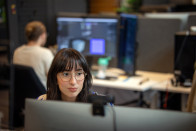Game development encompasses a lot of different roles. The most common roles at a game studio are in programming, art, and game design.
In essence, this is what the difference between those roles are:
- The game designers decide what will go in the game and how it should be played,
- the artists create all the visuals,
- and the programmers write code to bring it to life.
As we discussed in the previous chapter, bigger studios are likely to also have staff working in other areas, such as QA, audio, production, operational management, and marketing and community management. Bigger studios often also have specialized roles for people that truly excel in one discipline. Depending on what game a studio is making, they might also hire people for entirely different - and sometimes very unexpected - roles.
Job titles and job descriptions will vary slightly depending on the studio. Many titles also come with a prefix such as Junior or Senior, alluding to an individual's amount of experience. Another common word in games industry titles is Lead or Manager, indicating that the person with this title likely leads a team or has other added responsibilities.


